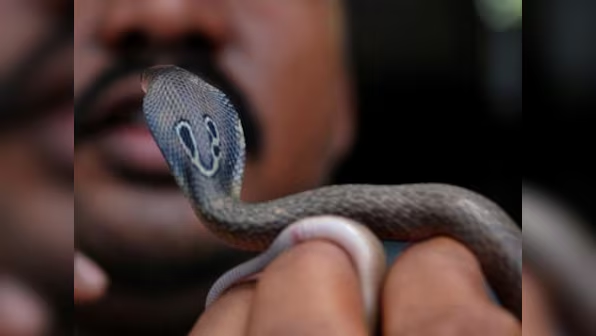Mumbai, India’s bustling financial hub, is witnessing an alarming rise in snake sightings within its urban confines. This trend, marked by snakes entering apartment complexes and buildings, is primarily attributed to rampant deforestation and significant climatic changes. The ongoing monsoon season has further aggravated the situation, making it a critical issue for the city’s residents and authorities.
Rampant Deforestation: A Key Driver
One of the primary reasons for the increasing snake invasions in Mumbai is the rampant deforestation in and around the city. Over the past few decades, rapid urbanization has led to the destruction of natural habitats, pushing wildlife, including snakes, into human-inhabited areas. Forested regions that once served as the natural habitat for these reptiles have been replaced by concrete structures, leaving snakes with no choice but to seek refuge in urban spaces.
The extensive construction activities, especially in the suburban areas of Mumbai, have resulted in the displacement of numerous snake species. Areas like Aarey Colony, which was once a green lung for the city, have seen a significant reduction in green cover due to ongoing development projects. This loss of habitat has forced snakes to move into nearby residential areas, increasing the likelihood of human-snake encounters.
Climatic Changes and Their Impact
Climatic changes have further compounded the problem of snake invasions in Mumbai. Rising temperatures and erratic weather patterns have disrupted the natural behavior and habitat of snakes. The city’s climate has become increasingly unpredictable, affecting the ecological balance and making it difficult for wildlife to thrive in their natural habitats.
The monsoon season, in particular, has seen a notable surge in snake sightings within urban areas. Heavy rains and flooding drive snakes out of their burrows and natural hiding places, prompting them to seek shelter in drier, elevated locations. This often leads them to enter homes, buildings, and apartment complexes in search of refuge. The monsoons, while a relief from the scorching summer heat, bring about a heightened sense of alertness among residents due to the increased risk of snake encounters.
Increased Snake Sightings: A Growing Concern
Reports of snake sightings in Mumbai have been on the rise, with residents frequently encountering these reptiles in their homes and neighborhoods. The situation is particularly concerning in suburban areas like Borivali, Kandivali, and Thane, where the proximity to natural habitats and ongoing construction activities contribute to a higher incidence of snake invasions.
In many cases, residents have found snakes in unexpected places such as kitchens, bathrooms, and even bedrooms. These encounters, while often harmless, can be terrifying and pose a potential risk, especially if venomous species are involved. The most commonly sighted snakes in Mumbai include the Indian rat snake, the spectacled cobra, and the Russell’s viper, all of which can pose significant dangers to humans if provoked.
The Role of Monsoons
The ongoing monsoon season has played a significant role in aggravating the issue of snake invasions in Mumbai. The heavy rainfall and subsequent flooding have led to a sharp increase in snake sightings. During the monsoons, snakes often venture into residential areas to escape the inundated conditions of their natural habitats.
The waterlogged environment forces snakes to seek higher ground, which often means entering human-inhabited spaces. The monsoons also lead to an abundance of prey, such as rodents, within urban areas, attracting snakes to these locations. This increase in prey availability further encourages snakes to venture into homes and buildings in search of food.
Human-Snake Conflicts and Public Health Concerns
The rising number of snake invasions in Mumbai has resulted in an increase in human-snake conflicts. Residents are often ill-equipped to deal with these encounters, leading to panic and, in some cases, injuries. While many snakes are non-venomous and pose little threat to humans, the fear and uncertainty surrounding snake sightings can cause significant distress.
Public health concerns are also paramount, particularly in the case of venomous snake bites. Mumbai’s healthcare infrastructure faces additional pressure during the monsoon season, with hospitals and clinics having to handle an increased number of snake bite cases. Timely medical intervention is crucial in such scenarios, as delayed treatment can lead to severe complications or even fatalities.
Mitigation Measures and Public Awareness
Addressing the issue of snake invasions in Mumbai requires a multi-faceted approach. Effective mitigation measures and increased public awareness are essential to reduce human-snake conflicts and ensure the safety of residents.
Habitat Conservation
One of the most critical steps is the conservation and restoration of natural habitats. Efforts to curb deforestation and protect green spaces can help reduce the displacement of wildlife, including snakes. Urban planning and development projects must incorporate environmental considerations to minimize the impact on natural habitats.
Public Awareness Campaigns
Public awareness campaigns play a vital role in educating residents about snake behavior and safety measures. These campaigns can provide information on how to identify common snake species, what to do in case of a snake sighting, and basic first aid for snake bites. Educating the public can help alleviate fear and promote a more informed response to snake encounters.
Collaboration with Wildlife Experts
Collaboration between city authorities and wildlife experts is crucial in managing the issue of snake invasions. Wildlife rescue teams can be deployed to safely capture and relocate snakes found in urban areas. These teams can also conduct regular inspections and provide guidance on making residential areas less attractive to snakes.
Emergency Response Systems
Enhancing emergency response systems is essential to ensure timely medical treatment for snake bite victims. Establishing dedicated helplines and increasing the availability of antivenom in healthcare facilities can significantly improve the outcomes of snake bite incidents.
Conclusion
The growing cases of snakes entering apartment complexes and buildings in Mumbai highlight the complex interplay between urbanization, climatic changes, and wildlife displacement. As the city continues to expand and environmental conditions evolve, it is imperative to adopt sustainable practices and proactive measures to mitigate the impact on both human and wildlife populations. Through habitat conservation, public awareness, and effective collaboration, Mumbai can address the challenges posed by snake invasions and create a safer environment for its residents.






